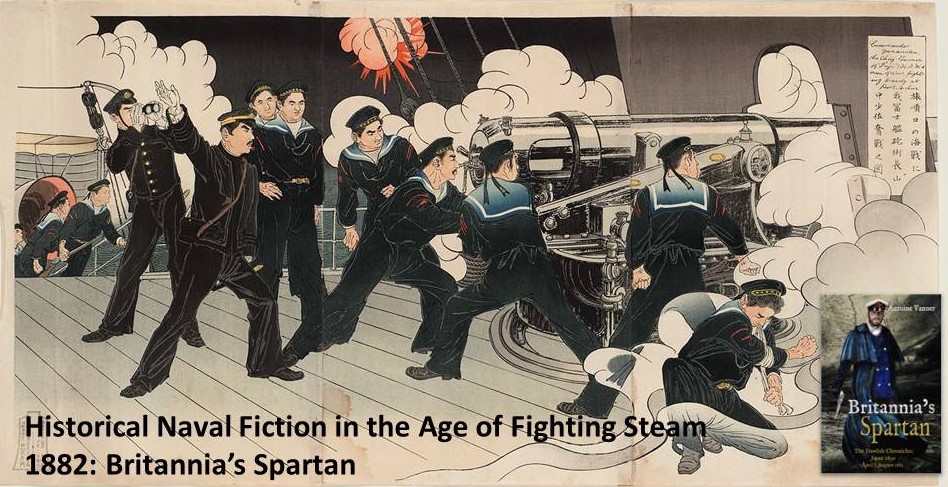Routine on a Royal Navy warship, late-19th Century
When one is interested in the navies of the late 19th Century, and especially when writing naval fiction set in that era, as I do in the Dawlish Chronicles, it is generally easy to access information about the ships themselves, their armament, their machinery and their performance. Somewhat more difficult is running down information on operations of the period, especially the myriad of small actions undertaken by the Royal Navy, many which involving landing of “naval brigades” of anything from a few dozen to several hundred men. What is hardest of all to pin down information on are the realities of daily shipboard-routine and the life led by officers and men.

A Naval brigade quelling rioting in Alexandria in 1882. Much of the Royal Navy’s active service in this era consisted of interventions onshore
In view of this, I was recently delighted to run down a volume, published in 1901 and entitled “The Handy Man, Afloat and Ashore”. The term “Handy Man” was used in this period to refer to seamen, recognising the fact that, living in a self-contained world for weeks or months, they were called on to manage or cope with any emergency or problem that might confront them. The author of this work was the Reverend G. Godenough, an Anglican chaplain who, by virtue of his position and duties, gained insights to the culture, attitudes and behaviour of “the lower deck” which other officers could not easily get. An earlier blog, of 27.03.2018 (click here to read) refers to descriptions that he gives of shore-leave in the Mediterranean in the 1890s.
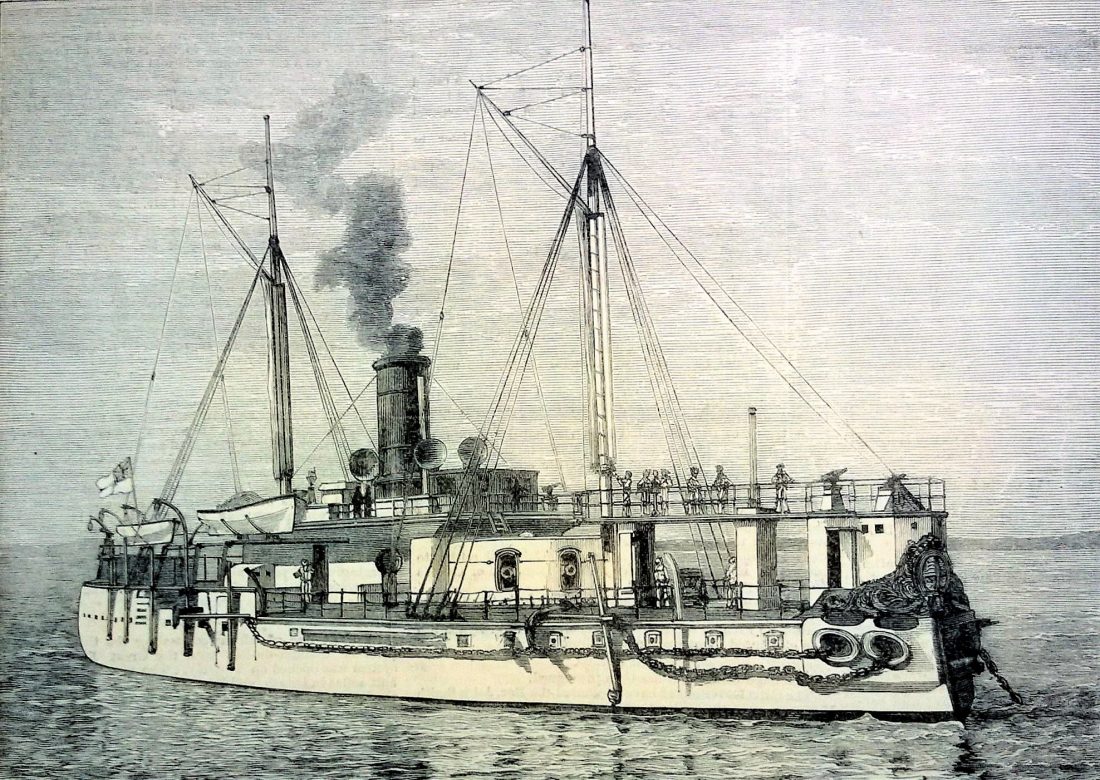
HMS Hotspur, a small and badly designed ironclad of the period. Note absence of torpedo nets at this early stage in her career
I have found of particular interest the details of the typical daily training routine for a large ship when in harbour. It was very intense and in the case of a battleship, such as HMS Trafalgar of 1887, on which Goodenough served, some exercises would involve several hundred men out of a total crew of 580. Sunday was a day of rest, other than for the morning religious service, but the six other days were well filled, as below:
Monday
Forenoon – General drill. Prepare for action and rig out torpedo nets.
Afternoon – Small-arm drill and gymnastics. 6 p.m. wash clothes. Inspection of guns.
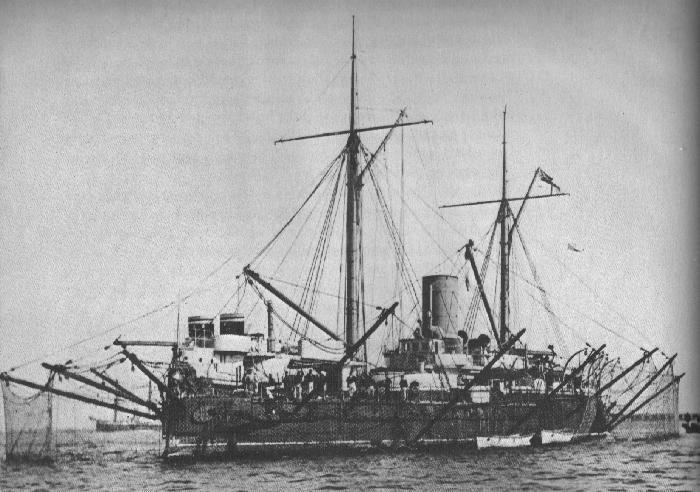
HMS Hotspur again, but now equipped with a “crinoloine” of anti-torpedo netting to be deployed when at anchor. This shows the vessel in the middle of the process of their deployment. Like all such other activities, ships competed to reduce the time needed for this to the minimum – hence the drills on Monday afternoons and Tuesday mornings.
Tuesday
Forenoon – Scrub hammocks every other week. Torpedo exercise. Drill by divisions.
Afternoon – Boat-sailing. Small-arm drill. Gymnastics. Inspection Of guns. Exercise manoeuvres of steamboats.
Wednesday
Forenoon – Torpedo exercise. Out torpedo-nets. Field-gun drill on shore if possible. Marines drill.
Afternoon – Cutlass exercise. Inspection of mines, electric cables,and circuits of guns. Midshipmen and boys at gun, small-arm drill.
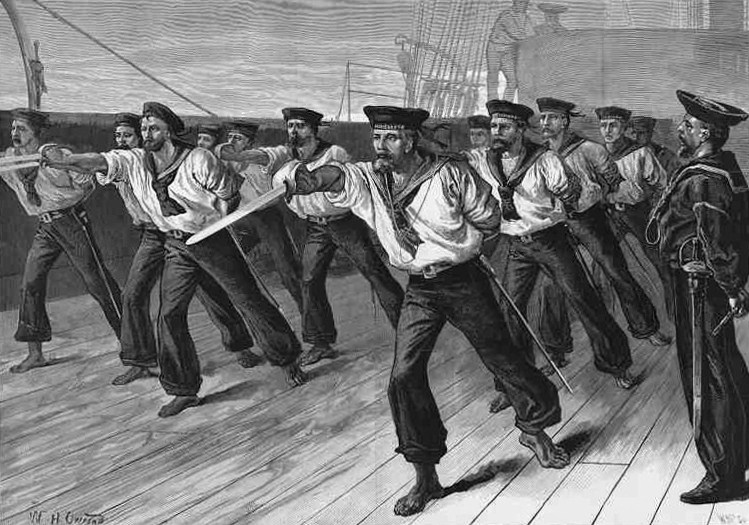
Cutlass drill in the 1880s – note the bare feet, still normal at this time
Thursday
Forenoon – Exercise landing parties-ashore if possible. Drill in passing up ammunition. Test hydraulic machinery. Muster clothes and bedding.
Afternoon – Make and mend clothes. Smoking permitted.
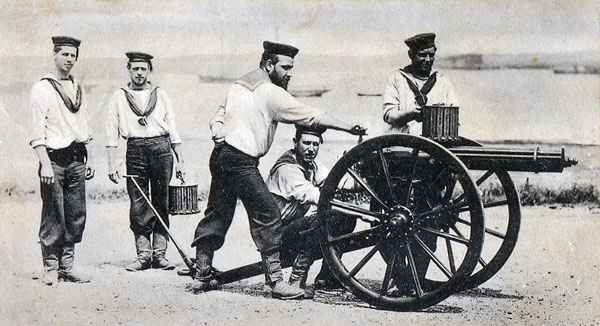
Landing party excercising with a Gatling on a field carriage. At sea this weapon would be most likely mounted in one of the tops. Larger ships also carried seven or nine-pounder field guns that could be broken down into parts for easy manhandling.
Friday
Forenoon – General quarters for action
Afternoon – Boat drill. Test gun-cotton. Once a month fire quarters.
Saturday
Clean ship. Test ship’s pumps.
On one Monday in the month the bedding was aired on the ridge ropes and hammock nettings – photographs of ships from all navies of the period sometimes show them festooned with drying bedding and clothing. Thursdays were muster day twice a month and once a quarter the Articles of War are read and new regulations are made known.
In addition, the ships of the period needed to take on coal at intervals – thousands of tons in the case of larger ships. The entire crew was involved in transferring the coal from lighters or colliers alongside, swinging it across on slings and dumping it down openings to the bunkers below. The worst duty of all fell on the trimmers who, working in confined space and often in very high temperatures, were required to distribute the coal evenly using shovels and wheelbarrows. Individual ships vied with each other to set coaling records – by World War 1 rates of 200 to 300 tone per hour were being achieved.
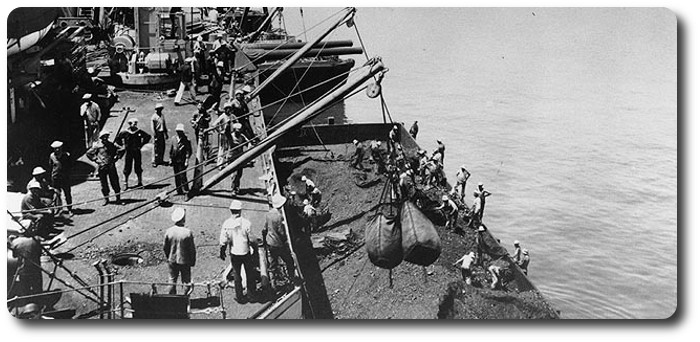
Coaling – always a filthy job. Seen here on an American battleship circa 1909
The Reverend Goodenough, who did not take part in the physical labour involved, had a breezy, even patronising, view of how crews approached it. He noted that “The men are as cheery as the (black) minstrels they resemble. In spite of the noise and the filth it is a jolly scene. Indeed, I rather liked coaling ship days (when I couldn’t get ashore) up to the time when the last bag was in and stowed, and then I wanted to be elsewhere. For, without a moment’s delay, hoses were got out, branch- pipes fitted and the ship presented a weird scene of grimy figures, up to the in liquid dirt, sending cascades of water into every nook and corner and driving me from post to pillar, and Pillar to post in the vain search for rest the sole of my foot, even my cabin being no longer a sure refuge, for that was possession Of by my servant busily trying to remove the fine coating of coal-dust that in spite of all precautions manages to find its way everywhere. So I learnt that it is the part of a wise man to be out of the ship when they are washing down, if he isn’t himself employed on that particular job of work.”
The chaplain also recounted what he described as “laughable incident at Port Said in my old troopship days.” On this occasion contracted local labour, rather then the ship’s own crew, undertook the coaling. One suspects that these Egyptians were not paid generously, for they “struck for more pay, and, not getting what they demanded, refused to ship (the coal) for us. So our own men were told off to do the job, which no sooner did the natives perceive than they repented and tried to begin work. But this didn’t suit our fellows at all. So the next thing we knew was that the bluejackets and marines were taking these gentlemen by the scruff of the neck, as they tried to board the coal- barges, and chucking them with infinite zest into the canal.”
Man of the cloth or not, the reverend chaplain’s attitude tells much about the values of the time and reflects little Christian Charity . There could only be a residue of bitterness following such an incident, which one suspects was not unique. It’s therefore not surprising that payback-time would eventually come when the Egyptians would nationalise the Suez Canal a half-century later, triggering a major crisis that culminated in Britain’s 1956 Suez debacle.
Having as far as possible avoided the hardships of coaling the chaplain ends on what today sounds like a a patronising note: “Coaling over and the ship washed down, the forecastle is always alive in the evening with music, vocal and instrumental. Banjos, mandolins, guitars, fiddles, are brought out and the night resounds with song after song. The harder the day’s work has been the heartier is the singing, as a rule.” One suspects that this may be closer to Gilbert and Sullivan’s HMS Pinafore than to reality.
Britannia’s Spartan
It’s 1882 and Captain Nicholas Dawlish RN has just taken command of the Royal Navy’s newest cruiser, HMS Leonidas. Her voyage to the Far East is to be a peaceful venture, unlike the baptism of fire he received there as a boy, this time a test of this innovative vessel’s engines and boilers.
Dawlish has no forewarning of the nightmare of riot, treachery, massacre and battle he and his crew will encounter.
A new balance of power is emerging in the Far East. Imperial China, weak and corrupt, is challenged by a rapidly modernising Japan, while Russia threatens from the north. They all need to control Korea, a kingdom frozen in time and reluctant to emerge from centuries of isolation.
Dawlish finds himself a critical player in a complex political powder keg. He must take account of a weak Korean king and his shrewd queen, of murderous palace intrigue, of a powerbroker who seems more American than Chinese and a Japanese naval captain whom he will come to despise and admire in equal measure. And he will have no one to turn to for guidance…
Britannia’s Spartan sees Dawlish drawn into his fiercest battles yet on sea and land. Daring and initiative have already brought him rapid advancement and he hungers for more. But is he at last out of his depth?
Click here to read the opening chapters free
You can read the whole book free if you’re a Kindle Unlimited Subscriber
Registering for the Dawlish Chronicles mailing list by clicking on the banner below, will keep you updated on new books and facilitates e-mail contact between Antoine Vanner and his readers for discussion of issues arising.
Suggestions and comment are always welcome and all emails are replied to. Free short stories, available only to those on the list, are also made available at intervals.

